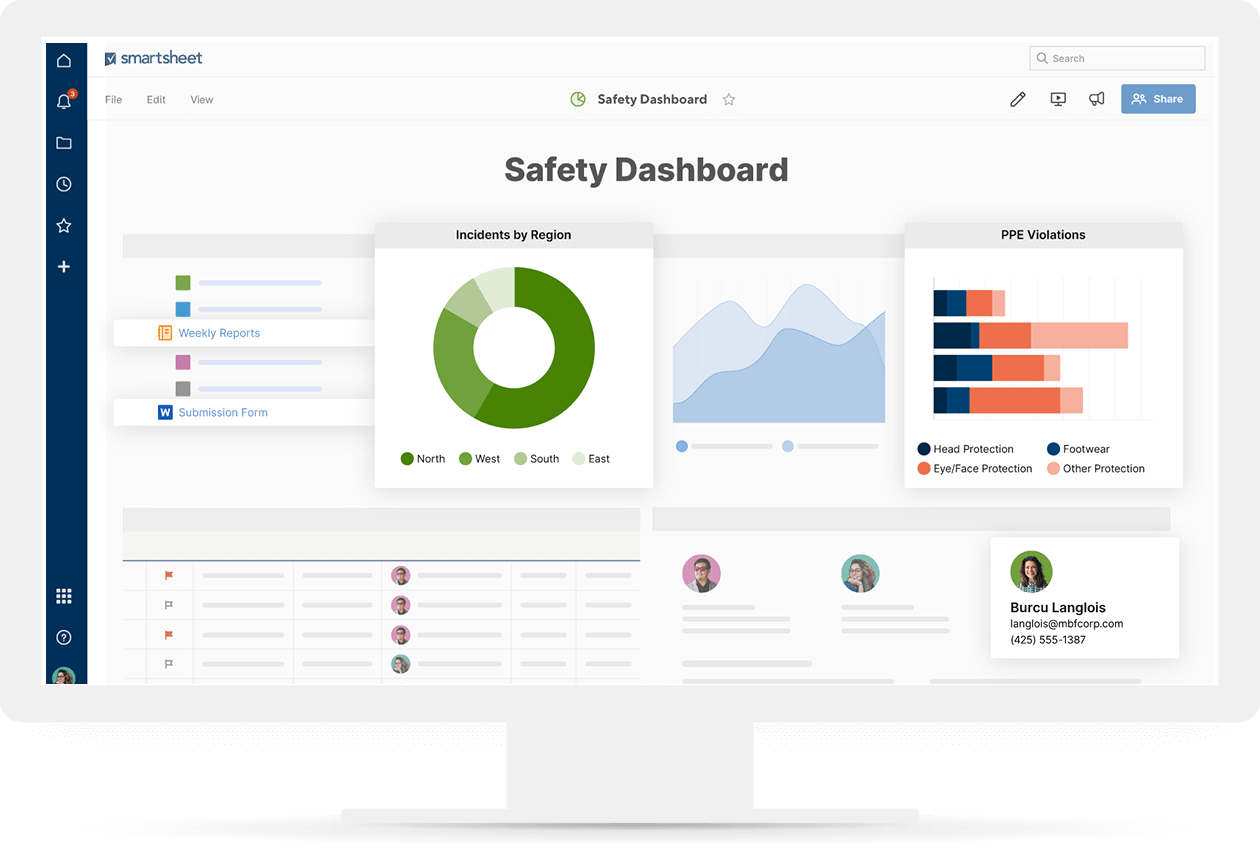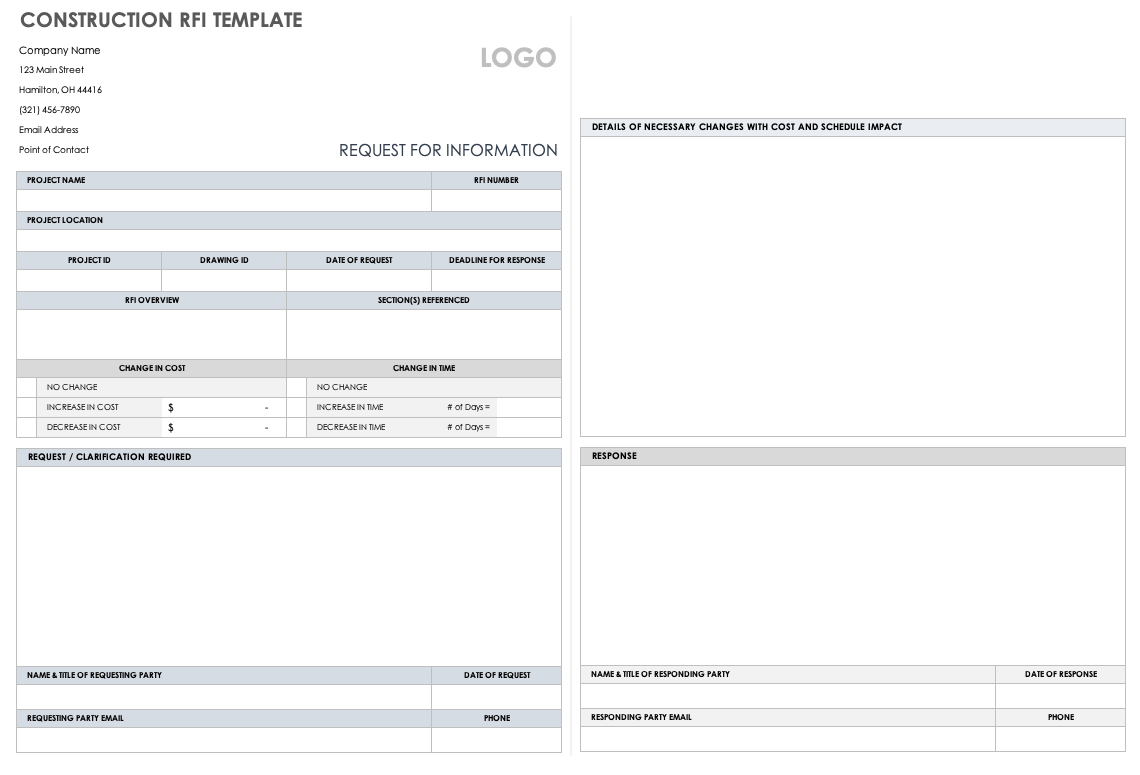What Is an RFI in Construction?
In construction, a request for information (RFI) seeks the clarification of plans, drawings, specifications, and agreements. The construction RFI is a formal written process in which parties, such as the contractor and designer, clarify information gaps in construction documents.
While this process sounds straightforward, RFIs often become a source of delay, expense, conflict, and even legal claims. Therefore, all participants in construction projects have a stake in understanding how RFIs work and how to use them properly.
Construction RFIs come into play at various points in the construction process. During bidding, a contractor may submit an RFI to gain a fuller understanding of the project’s details and fine-tune a quote.
More commonly however, a contractor or subcontractor will submit a construction RFI while building is under way in order to ask the designer or engineer to clarify a drawing or specification. The contractor or supplier may also use an RFI to document a concern about the specified materials, seek more information about the owner’s intended use, or recommend a change or substitution of components.
Giving prompt and complete answers to RFIs helps construction projects stay on time and within budget. Providing timely responses also helps ensure that the builders are constructing the edifice according to specifications.
Construction RFIs generally arise in one of three scenarios:
- When someone needs further information or clarification
- When someone proposes a substitution or an alteration
- When someone identifies a problem or deficiency
Transform construction management with Smartsheet. See for yourself.
Smartsheet enables you to track each project with its own dedicated project sheet and get a unified view across all projects in a dashboard. Monitor tasks across projects and capture on-site issues through a simple form on desktop or mobile.
Types of Construction RFIs
According to a 2012 study in the Journal of Construction Engineering and Management, there are more than a dozen primary types of construction RFIs. These include the following:
- Design Coordination: These RFIs involve organizing, communicating, and coordinating the design and associated documents among project participants.
- Construction Coordination: This category of RFI covers requests to organize and coordinate construction-related procedures, schedules, and safety items.
- Constructability Issues: These RFIs arise when the construction document articulates a detail or design that the contractor deems infeasible.
- Timing and Phasing: RFIs of this type occur when the builder needs to change the sequence of construction activities due to resource or labor constraints.
- Design Change: These RFIs seek to revise the design in order to facilitate construction or fix a construction mistake.
- Design Clarification: With this kind of RFI, the requester seeks more information about the design in order to better understand its details and how they relate to the project.
- Change in Method or Process: This category of RFI arises when the contractor wants to change a specified building or installation technique.
- Deleted Scope: These RFIs seek to remove work from the project.
- Incomplete Plans or Specs: This type of RFI points out errors or omissions in the plans and specifications.
- Material Change: With this type of RFI, the requester seeks to use a different material than the construction documents specify.
- Site Conditions: These RFIs emerge when builders discover a discrepancy between the description of site conditions in the construction documents and the actual site conditions.
- Utility Conflict: Use this type of RFI when utility lines (such as water pipes or power wires) stand in the way of proceeding with construction as originally planned.
- Value Engineering: This category of RFI seeks to make changes for the purpose of reducing cost, improving efficiency, or enhancing quality.
- Other Issues: This category covers any other types of RFI that might come up, such as requests related to warranties, certifications and inspections, penalties, and non-design documents.
Why Are Construction RFIs Important?
While no one likes more paperwork, RFIs are critical in the construction process because they influence safety, quality, budget, risk, and liability.
How you handle construction RFIs can have a big impact on whether or not your project comes in on time and within budget. A 2013 worldwide study of one million RFIs on 1,300 major construction projects, issued by the Navigant Construction Forum, found the following: The median response time was 9.7 days; the average cost for reviewing and responding to RFIs was $1,080; and the average number of RFIs per project was 796.
RFIs help you build a structure correctly and deliver high-quality projects and customer satisfaction. If you don’t answer RFIs fully and promptly, that negligence may lead to costly reconstruction work and, therefore, major expenses for the at-fault party, (i.e., the contractor, architect, or owner). No party is ever happy about shouldering extra costs.
Writing and responding to RFIs correctly can even mean the difference between life and death: RFIs ensure that builders use appropriate materials, that they perform the work in the specified manner, and that they keep the building and work site safe. For example, the 1981 collapse of a walkway inside the Hyatt Regency hotel in Kansas City caused the deaths of 114 people. Ultimately, it was found that inadequate communication between the architect and steel fabricator concerning the review of design changes accounted for the faulty construction.
RFIs act as documentation that project participants did their jobs correctly. If there are disputes later on, RFIs can support claims of negligence or fraud. Construction litigation is expensive and time consuming, so it’s important to handle RFIs with care.
How to Write a Construction RFI
You should write your RFI in a way that helps the architect, engineer, or other recipients to provide you with a helpful answer as quickly as possible. Standardize the format, state your question clearly, and give contextual information about the issue, including images.
Make sure your construction RFI includes the following elements:
- Project name and address
- RFI number (in sequential order for the project)
- RFI title (and a brief description)
- Date you submitted the RFI and a deadline for the response
- Name, title, company, and contact information for the requesting party
- Description of the request, beginning with the question and including a reference to the relevant specification, plan, or drawing
- Name, title, company, and contact information for the responding party
- Space for the response and response date
- A description of the attachments, such as photos, screenshots, invoices, etc.
- When necessary, a section to describe changes in cost or construction
Here is a sample of a completed construction RFI:
Free Construction RFI Template
The construction RFI template below includes all the necessary elements in a one-page format. With sections for the project name, RFI number, date of request, project location, project ID, drawing ID, RFI overview, and more, you’ll have everything you need to facilitate your project.
Download Construction RFI Template
Excel I PDF | Smartsheet
You can find more construction RFI templates, including an RFI log, a response to an RFI, and an RFI for government contractors, by reading “Free Request for Information Templates” and “Free Construction Project Management Templates.”
Tips for Producing Effective Construction RFIs
RFIs often cause frustration for both the issuer and the responder. You can lessen or even avoid this frustration by following some common-sense guidelines.
- Establish a clear RFI process for the project and your team, and make sure all participants follow it.
- Devote sufficient time during pre-construction to reviewing and understanding construction documents. Submit RFIs months before breaking ground, so you can minimize last-minute RFIs that might slow down work.
- Use a standardized RFI form and assign RFI numbers sequentially.
- Before writing an RFI, consult the project’s contract documents to verify that the answer to your question does not already exist. According to a study that the Navigant Construction Forum cited, more than 13 percent of RFIs are “not justifiable,” meaning that the answer to a submitted RFI already exists within a project’s contract documents. Navigant estimated that a large project’s various parties spend an average of $113,400 reviewing and responding to such unnecessary RFIs.
- Choose a name for each RFI that is distinct from other RFI titles.
- Write clearly and concisely.
- Adopt a neutral tone. Don’t try to make the architect or engineer look bad.
- Make sure the RFI asks a question. Don’t use the process to express an opinion, voice a disagreement, or inform parties of a future change.
- Ask only one question per RFI.
- Propose a solution, and, ideally, offer at least two options, so the architect or engineer only has to pick one.
- If possible, provide a time and money-based estimate of the RFI’s impact. Some experts argue against doing this, instead encouraging contractors to wait until they receive the response to the RFI, before presenting its impact. These experts reason that providing such details can delay response and increase friction; indeed, once you attach a price tag, the designer may be reluctant to make a recommendation.
- Specify all the information you need in order to facilitate the response. Remember to request such data as part numbers, color names, and installation techniques.
What Is the Construction RFI Process?
The construction RFI process governs the asking and answering of project questions. A contractor or subcontractor raises the RFI and sends it to the architect or other qualified consultant to answer the question, who then sends back a response.
If the party asking the question finds that the answer is insufficient, they may resubmit the RFI and seek further clarification. Or, the contractor may escalate the issue and seek a meeting.
On big construction jobs, a project manager often reviews RFIs and mediates the construction RFI process. Because these large projects involve so many people, including the design, engineering, and contracting teams, all parties usually handle RFIs electronically, keeping records of these documents and their responses. Each team should have an established process for assigning RFI responsibilities to a team member.
An RFI response may necessitate a change order (CO), which is a written request to change the scope of work — this can impact your budget and schedule. If the architect is not sure whether an RFI will require a change order, they may give notice of a potential change order (PCO). Keep in mind that RFIs are distinct from change orders (you record change orders in a change order log).
Construction RFI Best Practices
Establishing an effective construction RFI process at the outset of a project can reduce friction, expense, and delay. Owners should specify RFI procedures in construction contracts to make sure that all parties are aware of them. Use an electronic tool to improve the organization of your RFIs, and follow the additional construction RFI best practices below:
- Cover RFI Procedures in Contracts: In contracts, stipulate a workflow for RFIs. Define RFI-related terms and circumstances, including what constitutes a valid RFI, so that all stakeholders have a common understanding. Make sure all project participants, especially those in the field, implement the RFI system.
Create a standard RFI format for the project. Additionally, institute a time limit for designers to respond to RFIs (when outlining this particular procedure, give designers the option of explaining why they might need more time).
Daniel Hogan is a buildings expert who provides forensic analysis and construction defect consulting for the Hudson International Group. He says that a designer who needs additional time to fully answer an RFI can still respond promptly in order to advise other parties of when they can expect a complete response. This future answer will appear as an addendum to the construction documents. - Use Digital Tools to Manage RFIs: Using a digital tool to store, track, and monitor RFIs speeds communication and information sharing. You can store all of a project’s RFIs in a central location, share them among team members simultaneously, and allow design and engineering team members to collaborate on responses. These applications enable you to create an audit trail that shows when someone submitted an RFI, who received it, and what action that person took.
“A project dashboard tracks key metrics, and the number of RFIs can be among these,” says Jim Zack, Executive Director of the Navigant Construction Forum and Principal at James Zack Consulting. If the number of RFIs grows or persists, software can analyze the RFIs to determine if they concern a more general component of the project (e.g., electrical, plumbing, etc.) or refer to more particular parts of the structure. Once you figure out the focus of the majority of the RFIs, then you can direct your efforts to fixing the problems that are contributing to this trend. - Categorize RFIs by Importance: Consider instituting a system that ranks RFIs by level of importance or urgency. A 2016 RFI case study for the Associated Schools of Construction found that implementing such a system had the potential to decrease the response time for high-priority RFIs.
Similarly, make sure you have a system for escalating unresolved RFIs, especially as they pile up. To increase the visibility of such a backlog, you can include the number of outstanding RFIs on your project status updates. - Cultivate Personal Relationships: Hogan recommends putting effort into nurturing personal relationships among project participants in order to head off adversarial situations.
He emphasizes that all members of the design, engineering, and construction teams should work to build personal relationships through in-person meetings, phone calls, and occasional lunches. “Relationships are so crucial to achieving good outcomes,” he says.
He stresses that while this give and take can be helpful, some RFIs will still be inevitable, as informal, verbal agreements do not hold weight.
How to Respond to a Construction RFI
If you are an architect, engineer, or other specialist, you should respond promptly, cooperatively, and completely to RFIs — doing so helps the project and generates goodwill with contractors and subcontractors. Failing to respond to an RFI is a big mistake.
In the Navigant study cited earlier, 22 percent of RFIs never received a response. Sometimes, architects do not respond because they believe that the construction documents adequately address the question. However, failing to reply to RFIs can create legal liability. So, always respond, even if only to point out where you provided a particular answer in the original plans.
Read the RFI carefully, so you fully understand the question. Make your answer clear and specific. Provide a solution, and give an example if possible. Include drawings, photos, or any supplemental information (such as a link to a manufacturer’s product page) that would be helpful. Of course, remember to keep your tone courteous and professional.
Abuses of Construction RFIs
While the majority of RFIs are legitimate, some construction experts have noted an increase in the abuse of RFIs. These abuses occur when contractors use RFIs to establish future legal claims and ultimately raise profits.
“RFIs frequently result in claims or change orders,” explains Zack. “Sophisticated contractors are now examining the answers to RFIs with a microscope.” These builders might claim that project specifications did not cover certain work. And, while the various parties do discuss the issue, that piece of the project does not proceed, thus compounding delays and change orders.
When claims and change orders add up, the number of RFIs proliferates. According to the Navigant Construction Forum, once this happens, contractors begin using RFIs — rather than traditional channels such as construction submittals, schedule updates, phone calls, or substitution requests — for virtually all project communication. As the designers become overwhelmed by this increase in RFIs, they may fail to answer on time.
Collectively, these additional RFIs can create a paper trail to support contractors’ monetary claims for delays and changes. These contractors want to present a large number of RFIs to a court or arbitrator, so they can argue that the design for the structure was incomplete when they bid on the project, reports Navigant. This kind of charge may lead to a claim for an increase in costs or damages.
How to Reduce the Number of RFIs During Your Project
For owners, designers, and most contractors, reducing RFIs is a top goal. There are a number of ways to do so, including by selecting your project delivery method and project participants carefully.
- Ways for Owners to Reduce Construction RFIs:
- Zack recommends building ample time into the project schedule for the architect and engineer to complete high-quality designs. When owners pressure other parties to reduce costs, the project timeline can become drastically compressed. An insufficient timeline undermines the designer’s ability to execute thorough, detailed plans, and also compromises the designer’s ability to anticipate questions that the contractors might have. Zack advises clients to allocate 10 percent of their design budget to a quality review. “You either pay up front in planning and design, or pay later in change orders, submittals, and RFIs. It’s pay me now or pay me later,” says Zack.
- Consider design-build, building lifecycle management (in which designers, builders, and operators make decisions by considering a structure’s lifetime costs), and integrated project delivery methods. These strategies put the designer and builder on the same team, rather than in an adversarial relationship. As an example, Swire Properties Limited used building lifecycle management for the construction of a 70-story building in Hong Kong and issued just 140 RFIs — a 93 percent reduction from industry norms.
- Require contractors and subcontractors who bid on the project to sign an acknowledgement that they have reviewed all the construction documents and found them complete. Owners can also ask contractors to attest that they’ve based their bids entirely on the construction documents.
- Include a clause in your contractor agreements that compels contractors to use due diligence to find information — before submitting an RFI. This way, if an RFI requests information that you’ve covered in construction documents, the contractor becomes responsible for the designer’s cost to respond to the RFI.
- Ways for Architects and Engineers to Reduce RFIs:
- Before each phase of construction, hold a meeting with all the project participants, so you can review plans and answer questions together.
- Before selecting bids, offer to advise the owner on choosing qualified contractors. When pursuing a specialized project, such as an oil refinery, some owners may only invite one or two contractors (who they know are qualified) to bid on the work. However, the federal government generally restricts government-related organizations from doing this.
- Seek a contract clause that says you will respond to RFIs promptly and be entitled to compensation for responding to unnecessary RFIs.
- Perform document audits and peer reviews of designs to ensure that they are complete. Look at RFIs on your projects; see which type of issue they tend to concern more frequently, specific design elements or engineering ones. A 2019 study of steel construction RFIs found that contractors’ questions tended to focus most frequently on trusses, trusses’ connections, and the dimensions of plates or welds for those connections.
- Ways for Contractors and All Stakeholders to Reduce Construction RFIs:
- Pick project partners carefully. Look at a potential partner’s claims history. Seek the party’s references, and, talk to colleagues who have worked with this party.
- Make sure the project schedule is realistic.
When Not to Use a Construction RFI
Given how contentious RFIs can become, it’s important not to overuse them or use them in the wrong situation. To avoid the most common misuses of construction RFIs, do not use them as any of the following:
- A form of regular communication
- A progress report
- A change order or a request for a change order
- A submittal, transmittal, or plan
- A contract
- An opportunity to comment broadly about the project
- A safety plan
- A request for approval of changes to the overarching project methods
- A vehicle for adding primary design or engineering work
History of RFIs in Construction
Before modern times, a so-called master builder headed construction projects and oversaw both the design and the building work. As those disciplines became more separate and specialized, a need arose for a clear, standardized mode of requesting.
“The predecessor to today’s RFI came into use after the U.S. Civil War,” says Zack. “In the 1970s, field memos and verbal requests were common. The current version of construction RFIs dates from the 1980s,” when lawyers began advising clients that they would need better, more formal documentation to resolve legal claims.
Improve the RFI Process with Smartsheet for Construction
From pre-construction to project closeout, keep all stakeholders in the loop with real-time collaboration and automated updates so you can make better, more informed decisions, all while landing your projects on time and within budget.
The Smartsheet platform makes it easy to plan, capture, manage, and report on work from anywhere, helping your team be more effective and get more done. Report on key metrics and get real-time visibility into work as it happens with roll-up reports, dashboards, and automated workflows built to keep your team connected and informed.
When teams have clarity into the work getting done, there’s no telling how much more they can accomplish in the same amount of time. Try Smartsheet for free, today.



